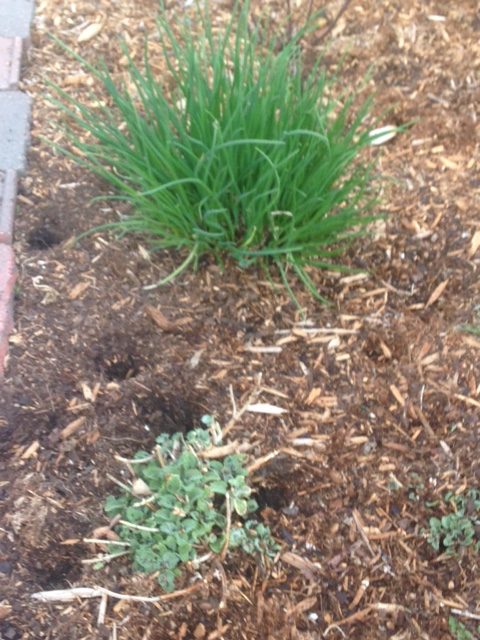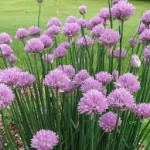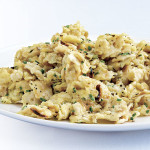Chives (Allium schoenoprasum) belong to the same family as onion, shallots, scallions, leeks, and garlic. They are a hardy, drought-tolerant perennial that grow to up to 12 inches tall. Chives are the only species of Allium native to both the New and Old Worlds and are widespread across much of Europe, Asia, and North America.

Chives
Chives grow in clumps from underground bulbs and produce round, hollow leaves that are much finer than onions. In mid-summer, they product round, pink flowers similar in appearance to clover. They prefer full sun and are tolerant of a wide variety of soils, but prefer soils high in organic matter. Chives are most commonly propagated by diving the clumps in early spring. To keep plants vigorous, divide them every 2-3 years. Chives will self-sow if you leave the flowers on. Chives provide a great deal of nectar for pollinators, so they are a great addition to any pollinator garden.
Chives can be easily grown in pots placed in a sunny location. Be sure the pots have good drainage. To achieve the best looking potted chives, dig clumps from the garden after a hard freeze.
Popular varieties include Grolau chives (a Swiss strain that has extra strong flavor and thick dark leaves), Nelly chives (has fine-texture leaves, blue-green in color and uniform upright habit), Profusion® chives (is a prolific producer of leaves and flowers and a good variety for pot culture), Staro chives, and Garlic chives (Allium tuberosum). Garlic chives are also called Chinese chives. The leaves are flat and not round and the flowers are white, not pink. They have a distinct garlic flavor.
Harvest chives throughout the season to prevent the leaves from becoming tough and to encourage formation of new bulblets. If you do harvest frequently, you should supplement with fertilizer during the season.
The medicinal properties of chives are similar to those of garlic, but weaker so they are not used very much as a medicinal herb. They have mild stimulant, diuretic, and antiseptic properties. Digestive problems may occur with overconsumption but since chives are normally used in small amounts this issue is rarely seen. Chives are rich in vitamins A and C, contain trace amounts of sulfur, and are also rich in calcium and iron.
The leaves, full flowers, and unopened flowers are all edible. Use leaves and flowers to flavor salads, dips, soups, stews, vinegars, cheese dishes, sour cream or butter. The flavor is much milder and more subtle than that of other members of the onion family. You can use the unopened flowers as well for fish, potatoes, soups and other dishes.
(presented by Barb McGill at the November 2018 NHS meeting)
From 2015:

History:
The chive plant, Allium schoenoprasum, is a member of the onion family and is native to northern North America and Eurasia. It has been collected from the wild since antiquity and has been cultivated since the Middle Ages. It is an old European custom to hang bunches of chives in doorways or on bedposts to ward off evil spirits.
Chives was used in traditional folk medicine to treat intestinal parasites and anemia and to stimulate digestion and the immune system. Pretty lavender flowers, a clump-forming habit and cold hardiness make this a nice garden perennial.
Cultivation:
Chives thrive in full sun and welldrained soil that is rich in organic matter. They are hardy to Zone 3. They will tolerate light shade but 6-8 hrs. of direct light is best. The easiest way of propagating chives is by planting rooted clumps in spring, after the danger of frost is past. Plants should be spaced 12 in. apart. Chives can also be started from seed. Established plants should be divided every 3-4 years in spring. Chives should be watered deeply when rain is infrequent to keep roots from drying out. A light mulch of ground-up leaves, compost or grass clippings will help retain moisture. Chives can be grown indoors in a bright, sunny location.
Uses:
Chive leaves have a mild onion flavor and are best used fresh in salads and dips or to season butter, cream cheese, vinegar or olive oil. They can also be used to flavor soups, vegetables, sauces, egg dishes, poultry and seafood. When cooking with chives, it is best to add the last 10 min. as prolonged heat destroys the flavor
The small puffs of flowers generally begin to bloom in late May or June. These are edible and can be used in salads as well as flower arrangements and should be picked when just fully open. They also make a beaut iful garnish or are tasty with eggs, fish and cheese dishes. When using the flowers in dishes, it is usually best to break into individual florets so the pungent flavor is not overwhelming. Harvest chives anytime during the growing season after the leaves are about 6 in. long by snipping leaves from base of the plant.

